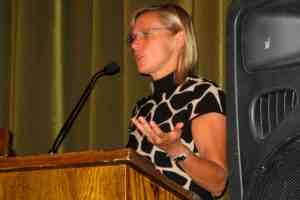Zoi went from celebrating what the administration has done, for example, earmarking $12 billion for home retrofit work and accelerating appliance efficiency standards development—to imagining what we can do. We can retrofit 5 to 10 million homes a year and 4 to 8 billion square feet of commercial buildings. We can save more than 5 Quads of energy in industry each year. We spend $1.1 trillion on stationary energy each year and a 20% savings means a $200 billion savings. We can meet 25% of our energy needs through efficiency by saving 3.5% a year, according the McKinsey Report. Art Rosenfeld put it in perspective—if we had done business as usual in this country since the Arab oil embargo in 1973, instead of saving about 2.5% a year because of the efforts of many people at Summer Study and other efficiency mavens, we would be spending $2.1 trillion on stationary energy this year instead of $1.1 trillion. It’s not just imagination! But can we cut refrigerator energy use in half, again?
Zoi would say yes, but…financial constraints, a scarcity of data, unconvinced regulators, and a public that has not yet got it, are obstacles to overcome. We have to improve our technology and our processes. For example, why not retrofit whole neighborhoods instead of a house here and a house there and save mobilization costs? And she needs the data! Send her the data—engineering estimates and actual performance data of energy savings and implementation costs. That will convince the regulators. To convince the public, find the language that sticks, e.g. "Retrofit Ramp-Up" is now "Better Buildings", and get the message out through structures that already exist, such as through utilities. DOE doesn’t have that much money for marketing.
The government has made a $12 billion down payment on energy efficiency, there are 7,700 energy efficiency projects in the works, and 17,000 good paying jobs have been created—irrefutable evidence that energy efficiency is good for the economy, at least for Summer Study attendees. It’s our job to convince the rest of the country.
37.7749295 -122.4194155
 Cathy Zoi is truly one of the rock stars of energy efficiency, having worked in the Clinton White House, for Al Gore, and now as energy efficiency’s woman in Washington.
Cathy Zoi is truly one of the rock stars of energy efficiency, having worked in the Clinton White House, for Al Gore, and now as energy efficiency’s woman in Washington.